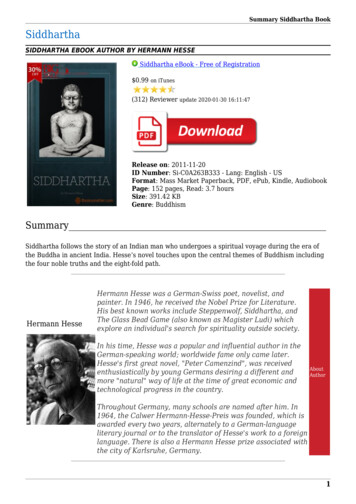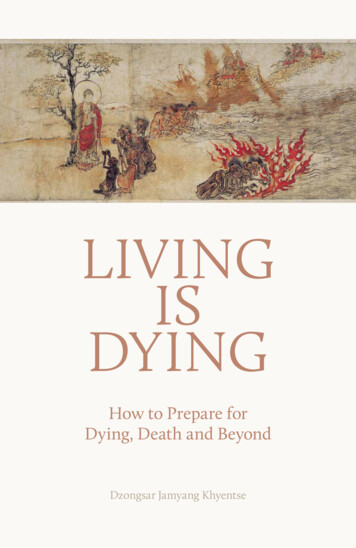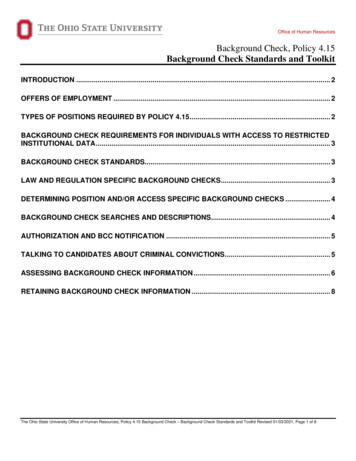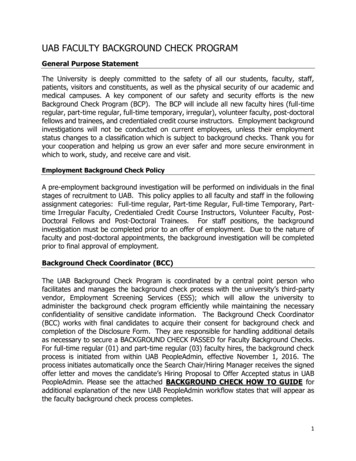
Transcription
SiddharthaBackground – Author, History, and CultureI. The Author: Hermann HesseHermann Hesse was born in the Black Forest town of Calw, Germany, in 2877. The Black Forest is amountainous district near the Rhine Valley. It is famous for picturesque scenery, tourist resorts, andskillfully-made toys and clocks. Hesse was the son and grandson of Protestant missionaries who hadserved in India. Hesse’s father expected the boy to follow in his footsteps by preparing for the ministry,and for a while Hermann did study at a theological seminary. In 1892, however, he experienced areligious crisis, fled the seminary, and attempted suicide. Unable to continue in high school, he spenthis late teens as a clerk in a bookshop and as an assistant to his father in a publishing house.From 1895 to 1899, Hesse was in Tubingen, where he began to write poetry and earned his livingworking in a bookstore. In 1899 he published his first book of verse, Romantic Songs. During the nextfour years, he traveled to Basel, in Switzerland, and composed lyrical works in the tradition of lateGerman romanticism: An Hour Beyond Midnight (1899) and Hermann Lauscher (1901). In 1903 Hessequit the world of business entirely to devote himself fully to writing.Hesse’s first major novels – Peter Camenzind (1904) and Beneath the Wheel (1906) – displayed somemajor themes that were to absorb the author throughout his career. The plot of Peter Camenzindcenters on the experiences of a young writer and suggests the dichotomy between two worlds: thedrab, mundane external world of business and the shining, inner world of art and the spirit. In Beneaththe Wheel, Hesse drew on his own experiences to explore the mind of a tortured adolescent who iscruelly oppressed by the “system” – in this case the expectations of his parents and teachers.In 1904 Hesse married; the following year he founded a liberal weekly periodical, with which he wasassociated until 1912. During 1911 and 1912, he crowned his long interest in Eastern cultures andreligions, which had fascinated him since childhood, with an extended visit to India. This trip was tobear fruit in two books: Siddhartha (1922) and The Journey to the East (1931).During World War I (1914-1918), Hesse joined the pacifist movement, and his anti-war sentimentsgained him extremely strong criticism. Previously a best-selling and popular author, he was branded asa virtual traitor. Then in 1916, his father died; his son Martin became seriously ill; and his wife suffereda severe nervous disorder and had to be put in a sanatorium. Deeply troubled, he moved toSwitzerland, where he remained for the rest of his life. He studied the works of Sigmund Freud andunderwent extensive psychoanalysis with one of Freud’s most celebrated disciples. Hesse’s profoundinterest in psychoanalysis and the workings of the subconscious mind probably dates from this periodand is clearly visible in his later fiction, including Siddhartha.Hesse’s Demian, published in 1919, was enormously successful and made the author a celebrity inEurope. The novel is a first-person account of an adolescent’s loss of innocence and his search for
identity and enduring values. In the prologue the narrator states what might well be an epigraph forSiddhartha, written three years later: “I have been and still am a seeker.”After Siddhartha Hesse’s most famous novel is probably Steppenwolf, published in 1927. This workoffended many readers, who failed to see that the book was not a glorification of sex and drugaddiction, but a search for the eternal in the transitory. Steppenwolf, like Siddhartha, highlights theconflict between inner integrity and the external, material world. Hesse’s later novels include Narcissusand Goldmund (1930), the story of a friendship between two priests in Medieval times, and MagisterLudi (1943). During World War II, Hesse remained in neutral Switzerland but bitterly protested theatrocities committed by the Nazis. In 1946 he was awarded the Noble Prize for Literature.In his last twenty years, Hesse lived in seclusion and published little. He died in 1962, just before hisworks became extremely wide-read in the United States. During the 1960’s, a well-known rock bandwas named Steppenwolf, one indication of the enormous popularity of his works. Many young peoplesaw Hesse has an advocate of an anti-materialistic counterculture and the search for truth in the mysticreligions of the East. This popularity, especially among young people, has encouraged a criticalreevaluation of Hesse’s work. While some critics remain skeptical of its enduring merit, many othershave now appraised the author as a major twentieth-century novelist and one of the most significantGerman contributors to world literature.II. Sources Of Siddhartha: The EastSiddhartha, set in India, is subtitled an "Indic Poetic Work," and it clearly owes much to Indian religions.But the question of the exact nature of Hesse's debt to various aspects of Indian religion and philosophyin Siddhartha is quite complicated and deserves detailed discussion. Elements of both Hindu andBuddhist thought are present and it is useful to make distinctions between them when the sources ofthe novel are discussed.A. Buddhism"Siddhartha" is one of the names of the historical Gotama, and the life of Hesse's character resemblesthat of his historical counterpart to some extent. Siddhartha is by no means a fictional life of Buddha,but it does contain numerous references to Buddha and his teachings.The basic teaching of Buddha is formulated in the Four Noble Truths and the Eightfold Path. Proceedingfrom the premise that suffering exists and that a release from it must be found, Buddha constructed hissystem. The First Noble Truth is the fact of suffering. The Second Truth is that suffering arises fromhuman desire for something, and that this desire can never be satisfied. The Third Truth is that there is away to achieve a release from suffering. And the Fourth Truth prescribes the manner of overcomingsuffering and attaining true knowledge.The first two steps in the Eightfold Path, which leads to the cessation of suffering, are rightunderstanding and right resolution; a person must first discover and experience the correctness of theFour Noble Truths (it is not sufficient to profess a superficial belief), and then resolve to follow the
correct path. The next three steps likewise form a kind of unit: right speech, right behavior, and rightlivelihood. These reflect the external aspects of a person's life, which must not be neglected. Theinterior disciplines constitute the final three steps: right efforts, right mindfulness, and rightcontemplation. By this means, the follower of Buddha can arrive at Nirvana.One critic, Leroy R. Shaw, has pointed out that Siddhartha is divided into two parts of four and eightchapters, and proceeds from this insight to interpret the work as an illustration of Buddha's Truths andPath; in the first chapter Siddhartha learns the existence of suffering, in the fifth (which corresponds tothe first step of the Path) he begins his journey along the correct path, etc. Shaw, then, comes to theconclusion that at the end "the difference between Siddhartha and Gotama, which had seemed so vastto the seeker at his meeting with the sage, becomes non-existent." This is certainly true in one respect;both Gotama and Siddhartha have arrived at a final condition of Harmony (although the nature of theHarmony differs considerably). But Siddhartha's way was clearly not that of Buddha. The division of fourand eight seems nevertheless to allude to the Truths and the Path, since a more natural division of thenovel, considering its structure, would be into three sections of four chapters each.Other aspects of Buddha's teachings are also of interest. Buddha was rather logical, scientific, andrational in his approach. He did not speak of supernatural phenomena or an afterlife, and he dismissedthe possibility of miracles. Buddha taught self-reliance. He had little use for rituals and formalistic laws,and he urged each man to work out his own salvation-which would, of course, be possible only withinthe framework of the Four Noble Truths and the Eightfold Path. The historical Gotama, like the figure inSiddhartha, taught that love and deep attachment to anyone or anything was wrong, since it leads tosuffering. Buddha never defined the state of Nirvana as he understood it, beyond saying that in it thecessation of suffering is attained, and that this is accomplished by the absolute extinction of the will.B. HinduismElements of this Indian religion are also present in Siddhartha. Hinduism is not as dogmatic asChristianity, or even as Buddhism. One important - perhaps the most important - aspect of Hinduism isthe concept of the Search or Quest for Truth. Whereas the Buddhist and the Christian each has a specific(if ultimately unknowable) goal and general guidelines which he can follow to attain it, for the Hindu thequest itself is all-important. As T. W. Organ aptly remarks, "The Christian says, 'Seek and ye shall find.'But the Hindu says, 'Seek and ye shall find.'"There are obvious parallels between Hinduism and Siddhartha, and these have not been overlooked bycritics. Most critics even assert that Hinduism is a more significant source for the book than is Buddhism.Eugene F. Timpe, for example, in a study which is methodologically similar to that of Shaw, has analyzedparallels between Siddhartha and the Bhagavad Gita, an important poetical document of the Hindureligion. Timpe maintains "that Hesse was influenced largely by the Bhagavad Gita when he wrote hisbook and that the protagonist was groping his way along the path prescribed by the Bhagavad Gita."Hesse was indeed familiar with this important work, and a comparison between it and Siddhartha isrewarding.
As Timpe points out, the basic central problems of Siddhartha and the Gita are similar: how can thehero attain a state of total happiness and serenity by means of a long and arduous path? Thedevelopment of each character is divided into three distinct stages: in Siddhartha there are – as onewould expect in Hesse - innocence, followed by knowledge ("sin"), which, together, lead to a higherstate of innocence accompanied by increased awareness and consciousness.In the Gita the path is similar, but not identical. It goes from action to knowledge to wisdom. Action isthe first stage in the hero's long road to perfection. Not arbitrary human actions are meant, but rather aform of action produced by acceptance of the Divine element in an individual. The person then movestoward knowledge-knowledge of the Self and of the Absolute, which ultimately are revealed to beidentical. The renouncing of all earthly attachments is a necessary component of each of the first twostages of development. A kind of self-fulfillment is stressed. An individual must find and follow his ownpath, for the ultimate goal cannot be attained by any form of imitation, however noble and admirablethe model or teacher may be. The final, and highest, stage is characterized by reverence and wisdom.The seeker reveres and even worships the Absolute, with which he is identical.Direct parallels with Siddhartha can be drawn. Hesse's hero seeks his own path to fulfillment. Althoughhis path is one of trial and error, he is always at least unconsciously aware of the nature of his quest. Hecomes to realize that seeking a goal will ultimately prove to be limiting. From Vasudeva he acquiresknowledge of what true action is. Finally, he is transfigured and attains wisdom.C. Hesse's Comments On Indian ReligionIn 1932 Hess published a "diary fragment" written some twelve years earlier, during the composition ofSiddhartha. In this interesting and revealing essay, he comments extensively on Indian religion. Hisremarks are important, but should not be accepted uncritically as the "final word" on any of the subjectswhich he discusses.In the diary Hesse acknowledges his long-standing interest in India. He says that this interest waspreviously largely confined to questions of philosophy, but that recently has become more orientedtoward religion. He sees Buddhism as a kind of "Reformation," but - like all religious reformations - iteventually tends to be more destructive than constructive. (Ultimately Buddhism denies rather thanaffirms life.) Hesse discusses the Buddhistic conception of Nirvana, and observes that whereas hepreviously accepted the doctrine, he now inclines toward the belief that God respects individuality.Buddha may well have reached Nirvana, but other men will not be able to find a "shortcut" by followingand imitating him. Hesse rejects the rationalism of Buddha's teachings which, he says, previouslyattracted him. The mystical aspects of Christianity acquire correspondingly more appeal. Hesse, then,feels that he is moving away from the philosophical position of Buddhism.Many of the themes of Siddhartha can be seen reflected in Hesse's discussion of Buddhism in the essay.The title character of Hesse's story objects to the negative (destructive) aspects of Gotama's teaching.He rejects Gotama's way as a model for himself, although he recognizes the greatness of the Buddhaand he insists upon the right to reject all teachers in favor of his own individual path to fulfillment.
Focus QuestionsPlease answer the following questions about the background on Siddhartha.1. What is Hesse’s experience with Christianity?2. What two ideas are introduced in Hesse’s first two books that are also evident in Siddhartha?3. What trip did Hesse take that would eventually affect the subject of Siddhartha?4. As a result of being branded a traitor and familial issues, where did Hesse move in 1916?5. What psychoanalyst did Hesse study extensively after his move? What did this analyst mostresearch?6. What topic does Hesse’s novel Steppenwolf explore that is also investigated in Siddhartha?7. What award did Hesse win in 1946?8. After which of Hesse’s books was a well-known rock band named in the 1960’s?9. Which two Eastern philosophies are prominently featured in Siddhartha?10. What historical figure has the name “Siddhartha”?11. To what extent does Siddhartha reflect the life of Buddha?12. Outline the premises of the Four Noble Truths.j13. Outline the three units of the Eightfold Path.
14. How does the structure of Siddhartha reflect the Four Truths and Eightfold Path?15. What would seem to be the more logical structure for Siddhartha?16. What is perhaps the most important Hindu truth when discussing Siddhartha?17. What important Hindu document does Siddhartha reflect? In what ways are the two similar?18. What was Hesse’s final opinion of Buddism?19. Given Hesse’s Christian background, interest in Hinduism and Buddhism, and his experience withFreudian psychoanalysis, what do you expect Siddhartha’s quest to entail and encompass?
Siddhartha, written three years later: "I have been and still am a seeker." After Siddhartha Hesse's most famous novel is probably Steppenwolf, published in 1927. This work offended many readers, who failed to see that the book was not a glorification of sex and drug addiction, but a search for the eternal in the transitory.









